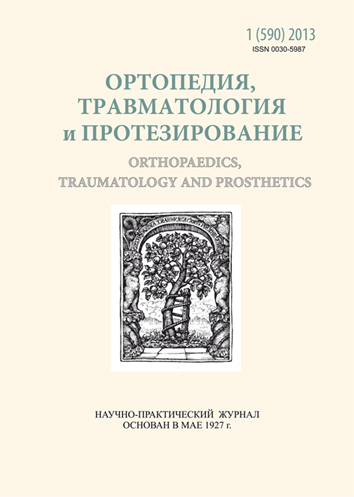Study of the diagnostic value of a polymerase chain reaction for early diagnosis of experimental tuberculosis of bones and joints
DOI:
https://doi.org/10.15674/0030-59872013155-59Keywords:
experimental modeling, tuberculous gonitis, polymerase chain reaction, dignosisAbstract
The purpose of the present work was to study the diagnostic value of a polymerase chain reaction (PCR) in a new experimental model of tuberculous gonitis, created by the authors, and examine peculiarities in the clinical-pathomorphological course of tuberculosis of bones and joints (TBJ). Features of the clinical-pathomorphological course of tuberculous disease of joints were studied as result of an experiment, conducted on guinea pigs with use of an original procedure. The analysis of results of the above research made it possible to reveal that the diagnostic sensitivity of PCR was 80 % at the prearthritic stage of the disease development and 100 % at its arthritic one. At the same time, the specificity of the chosen technique was 100 %, thereby enabling us to draw a conclusion that the use of PCR of synovial fluid in the arsenal of diagnostic methods for patients with TBJ is reasonable.References
- Vishnevsky B. I. The sensitivity and specificity of the test, based on polymerase chain reaction in the diagnosis of tuberculosis of peripheral lymph nodes / B. I. Vishnevsky, E. D. Mirlina, E. M. Belendir // The problem of tuberculosis. — 1998. — № 4. — P. 41–44.
- Vishnevsky B. I. Features bacterioexcretion and drug resistance of mycobacteria among patients with extrapulmonary tuberculosis / B. I. Vishnevskiy, O. A. Manicheva, E. B. Vishnevsky // Problems of tuberculosis and lung diseases. — 2006. — № 11. — P. 18–21.
- Oleynik V. V. Etiotropic and pathogenetic treatment of osteo-articular tuberculosis / V. V. Oleynik, L. A. Skvortsova, T. I. Vinogradov // Surgical treatment of osteo-articular tuberculosis / Ed. Yu. N. Levashev, A. Yu. Mushkin. — SPb., 2008. — P. 41–46.
- Pat. 70401 Ukraine, the IPC G09B 23/28. Method of modeling tuberculosis of bones and joints in animals / Korzh M. O., Diedukh N. V., Golka T. G.; the applicant and patent owner Sytenko Institute of spine and joint pathology Ukrainian National Academy of Medical Science. — №u20111317; Appl. 21.11.11; publ. 11.06.12, Byull. № 11.
- Tuberculosis in Ukraine: [the analytical and statistical manual of 2000–2011] / Ed. Tolstanov O. K. — Kyiv, 2012. — 98p.
- Feshchenko Yu. I. Organization of treatment of TB patients / Yu. I. Feshchenko, V. M. Melnik. — Kiev: Zdorov’e, 2009. — 488p.
- Sharma S. K. Extrapulmonary tuberculosis / S. K. Sharma, A. Mohan // Indian J. Med. Res. — 2004. — P. 316–353.
- Zhou Y. Differentiation of sarcoidosis from tuberculosis using real-time PCR assay for the detection and quantification of Mycobacterium tuberculosis / Y. Zhou, H. P. Li, Q. H. Li // Sarcoidosis Vasc. Diffuse Lung Dis. — 2008. — Vol. 25, № 62. — P. 93–99.
Downloads
How to Cite
Issue
Section
License
Copyright (c) 2014 Taras Golka

This work is licensed under a Creative Commons Attribution 4.0 International License.
The authors retain the right of authorship of their manuscript and pass the journal the right of the first publication of this article, which automatically become available from the date of publication under the terms of Creative Commons Attribution License, which allows others to freely distribute the published manuscript with mandatory linking to authors of the original research and the first publication of this one in this journal.
Authors have the right to enter into a separate supplemental agreement on the additional non-exclusive distribution of manuscript in the form in which it was published by the journal (i.e. to put work in electronic storage of an institution or publish as a part of the book) while maintaining the reference to the first publication of the manuscript in this journal.
The editorial policy of the journal allows authors and encourages manuscript accommodation online (i.e. in storage of an institution or on the personal websites) as before submission of the manuscript to the editorial office, and during its editorial processing because it contributes to productive scientific discussion and positively affects the efficiency and dynamics of the published manuscript citation (see The Effect of Open Access).














